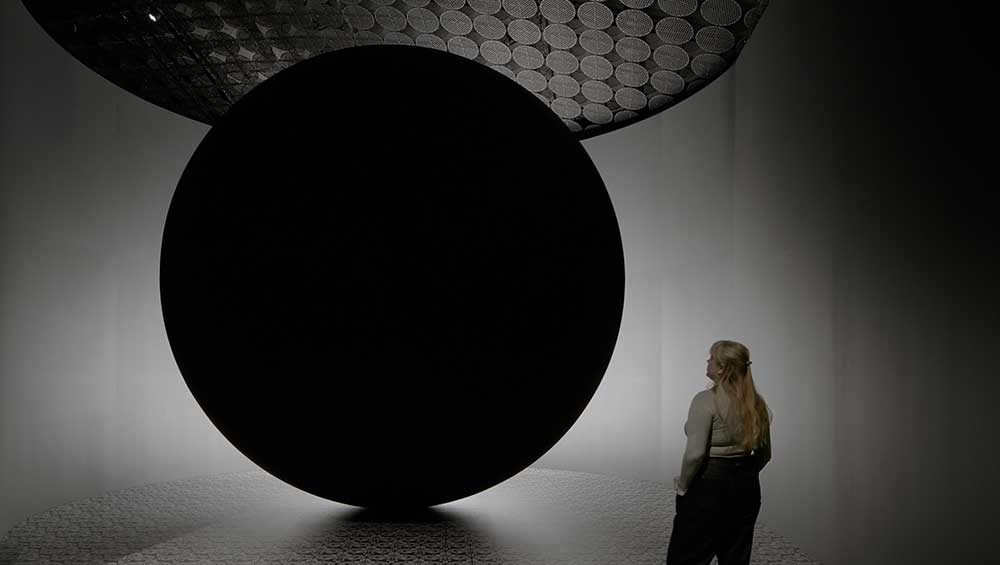
Larissa Sansour, Monument for Lost Time, 2019. Photo: Tuomas Uusheimo / Amos Rex.
Amos Rex, Helsinki
9 October 2024 – 2 March 2025
by CHRISTIANA SPENS
The vast, underground galleries at Amos Rex are kept in darkness, giving the impression of an underground bunker, where visitors must rely on the light from films and minimally lit installations to illuminate their path through the exhibition. These films, playing on large screens, are the work of Palestinian Danish artist Larissa Sansour (b1973), in collaboration with the writer and director Søren Lind, and curated in this show by Terhi Tuomi. The first, In Vitro (2019), was originally shown in the Danish Pavilion of the Venice Biennale. It is a striking black-and-white sci-fi film set in Bethlehem in the aftermath of an ecological disaster, and tells the story of a mother, Dunia, and Alia, who is a clone of her daughter, who died in the disaster.

Still from Larissa Sansour & Søren Lind's video work In Vitro, 2019. Courtesy of Larissa Sansour & Søren Lind.
In Vitro presents an intense dialogue that captures the unfathomable trauma of loss, which here has been implanted into the cells of a new human body, creating in Alia a longing for wholeness that seems impossible because of the physical situation of her existence. Created in the image of Dunia’s daughter, she carries with her memories of a girl who is no longer alive; she is in limbo, bearing the memories of the dead, the wishes of the surviving, and a personal confusion about how she can live freely. The Latin title In Vitro (literally, “in glass”) refers to scientific procedures that take place outside a living body, in an artificial space; it resonates with the format of the exhibition itself, but also the existential state of Alia, who has been brought up in a lab, away from the destroyed homeland, and now given the mission of repopulating and replanting this post-apocalyptic space.
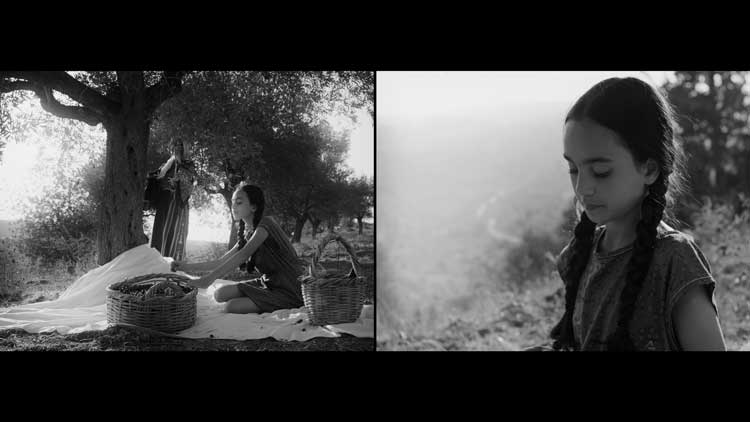
Still from Larissa Sansour & Søren Lind's work In Vitro, 2019. Courtesy of Larissa Sansour & Søren Lind.
By setting the film in Bethlehem but diverting the story from the immediately obvious political setting that inspired it, Sansour captures a feeling of displacement in her characters as well as emphasising the universalism of these crisis. There is an overwhelming sense of the tyranny of collective memory and narrative, and the trauma at its root; Alia is so caught up in Dunia’s expectations and loss that she cannot see a path forward even as she represents hope for a better future. She laments a sense of self that she has never really had, a freedom she has been promised but cannot truly experience because she is merely the sum of another’s implanted memories, and the sheer dislocation of existing with so much death around her and within her. In this way, Sansour captures the Palestinian experience but also a more universal existential crisis, a recognition of the limbo in which all humans exist to some degree, straddling the loss that drives our very existence, and caught in a loop of idealising the future but falling short of being able to manifest it. In Alia’s resistance, however, it seems as though she does manage to self-actualise; she creates in her new expression, in her pushing back against the fate she has been given, a person who did not exist before her in quite this way, regardless of her inherited genes or the implanted memories with which she must live.
There is something in this film, and the others here, of a dark fairytale, and a young woman wishing only to escape the curse that befalls her – in this case, the devastation from which she is born. Alia and Dunia discuss the fact they are stuck between reality and mythology:
Alia: “The only past I know is here. Everything else is just fairytales.”
Dunia: “Entire nations are built on fairytales. Facts alone are too sterile for a cohesive understanding. Soon, what we have achieved here will create a myth of its own.”
There are shades of Ingmar Bergman’s films, particularly Persona (1969), which also features two women who are fundamentally enmeshed with one another, and struggle to know themselves separately. There is a similar desire both for connection, and a kind of love and recognition, opposed to the desire for individuality through detachment from the other. And while Bergman breaks down the fourth wall to displace and complicate the narrative further, here, Sansour has created an imposing installation as a companion piece to the film, which emerges in a room to the left of the screening, the walls only just containing a large sphere, Monument for Lost Time (2019), which resembles a planet or a wrecking ball. While we may feel like mere spectators as we start to watch the film, by its end we feel we are inside it, with this large object suspended, looming and dangerous, like a planet eclipsing our sun. Sansour takes a personal narrative and in careful perspective shifts, she illuminates its universality.
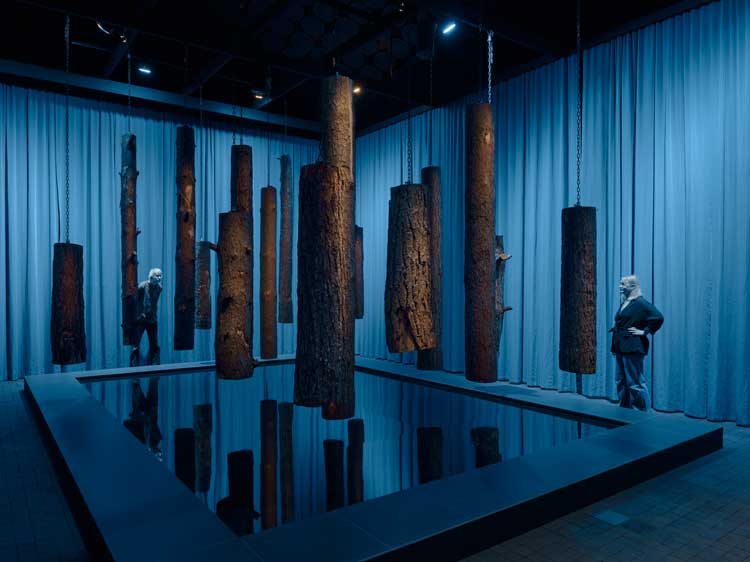
Larissa Sansour, As If No Misfortune Had Occurred in the Night, 2022. Photo: Tuomas Uusheimo / Amos Rex.
In the next main space, there is another film, Sansour’s most recent, As If No Misfortune Had Occurred in the Night (2022). An Arabic-language opera, featuring a Palestinian soprano, Nour Darwish, it is arranged over a three-screen projection, like a triptych, and is also shot in black and white. The aria is composed by Anthony Sahyoun, based on Gustav Mahler’s Kindertotenlieder and a traditional Palestinian song, Al Ouf Mash’al. Kindertotenlieder, premiered in 1905, set to music a collection of poems written by the poet Friedrich Rückert lamenting the death of his two children; Al Ouf Mash’al is the lament of a Palestinian woman whose lover has been lost after being enlisted into the Ottoman army in the first world war. The aria blends these two pieces of music and the stories they tell into a work of communal grief over 100 years, expressing in a new figure the grief of a mother, and the all-encompassing darkness of that loss. The words are particularly haunting:
Now the sun will rise as brightly
As if no misfortune had occurred in the night
A little light has been extinguished in my household
The misfortune has fallen on me alone
I mourn not only the losses I can count
But also those ahead and yet unnumbered
Each tragedy shared with those still unborn
My blood delivering the words
I forbid myself to speak
Oh daughter, oh my daughter
I didn’t invite the demons in
Yet they rummage through my veins
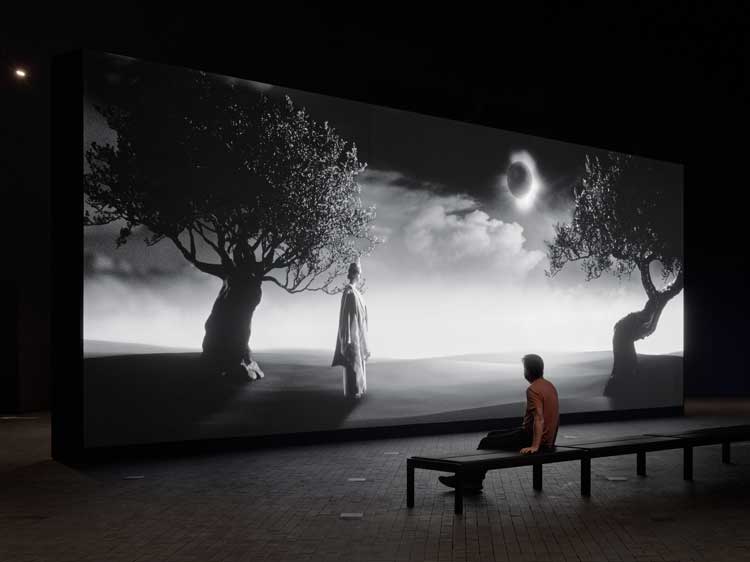
Larissa Sansour, As If No Misfortune Had Occurred in the Night, 2022. Photo: Tuomas Uusheimo / Amos Rex.
In the film, the soprano lowers herself into a bath of indigo dye, in a striking sequence that seems at once like a baptism and a burial. It is filmed in a derelict chapel, interspersed with archival footage from the first world war and scenes from Palestine at the start of the British Mandate, giving a sense of the immense weight of history present in this one story of personal grief. The indigo dye, associated with mourning in Palestine, colours the soprano’s white dress as she submerges herself in it; to the side of the screen there are swathes of fabric dyed the same colour, which demarcate another installation – this time tree trunks suspended over a pool by chains hanging from the ceiling. From inside the installation, you can see the film continue, creating an eerie perspective from which to see it, in layers of blue. The natural – the trees and the water – have been cut and suspended from above, dyed a dark, mournful blue, the pigment permanently dying anything in contact with it.
.jpg)
Still from Larissa Sansour's: A Space Exodus, 2009. Courtesy of the artist.
These films and installations, together with a series of bronze sculptures (Archaeology in Absentia, 2017) and a sci-fi video trilogy, comprising A Space Exodus (2009), Nation Estate (2012) and In the Future They Ate from the Finest Porcelain (2016), form an overall narrative that catapults us out of typical spans of history. Recalling Stanley Kubrick’s 1968 film 2001: A Space Odyssey, this last trilogy of films carries Sansour through space to the surface of the moon. From a sense of being compressed, imprinted and crushed by the intergenerational effects of catastrophe, carried through states of disagreement and then mourning, the exhibition provides this landing space, even if it appears to be in outer space, beyond the realms of what seems possible, and certainly beyond what is familiar. The characters travel from limbo and darkness to a new world, from being implanted by the memories and fates of others, to writing new stories. In this meditative, dark space, there is a gravitational pull to darkness, perhaps a sort of death drive, a confrontation with the death and destruction that has already happened and continues to happen repeatedly. After annihilation, and all these perspective shifts and states of mourning, after loops of loss and trauma, and the repetitive compulsions they put into effect, gradually the characters come into new existences. Where in the first room, a spherical object seems to loom and haunt us, lodged in a corner of our unconscious, blocking a light we did not know we had, by the end it is a glowing moon where we may land.
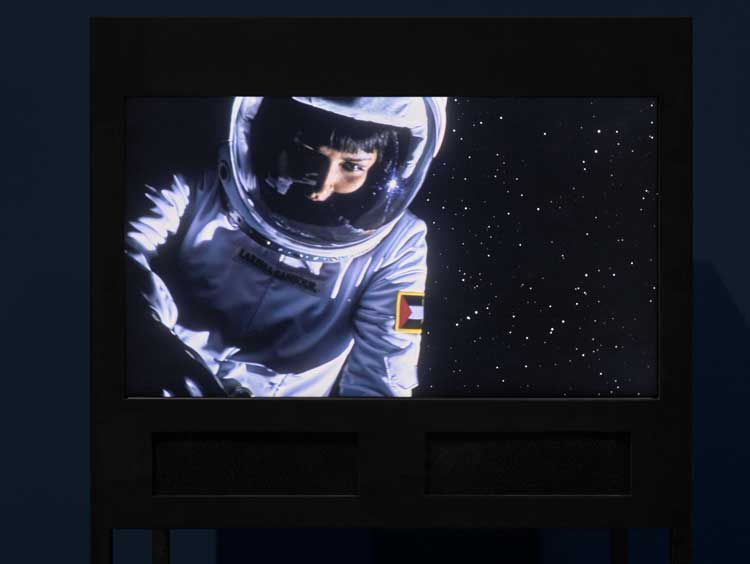
Larissa Sansour, A Space Exodus, 2009. Photo: Tuomas Uusheimo / Amos Rex.
The longstanding conflict between Israel and Palestine is painful and difficult to discuss, but somehow Sansour manages to do so directly and beautifully, creating space for mourning and disagreement, and revealing the ways in which it cuts to the heart of universal human fears about annihilation, belonging and self-determination. As she has said of her work in this context: “In recent years, I have been working with the concepts of loss, memory and inherited trauma, in reference to the violence and dehumanisation perpetrated against the Palestinian people for more than a century. The scale of the human tragedy currently unfolding in Gaza further accentuates the cyclicality of violence and oppression, and I am very grateful to Amos Rex for giving a platform to Palestinian voices in this dire time.”
As Kieran Long, director of Amos Rex Museum, says: “The artist’s video works and installations evoke empathy and understanding, which feels crucial at this point in time. We hope the exhibition will offer visitors a space for new ideas and encounters. Above all, of course, we hope for peace in Palestine.”